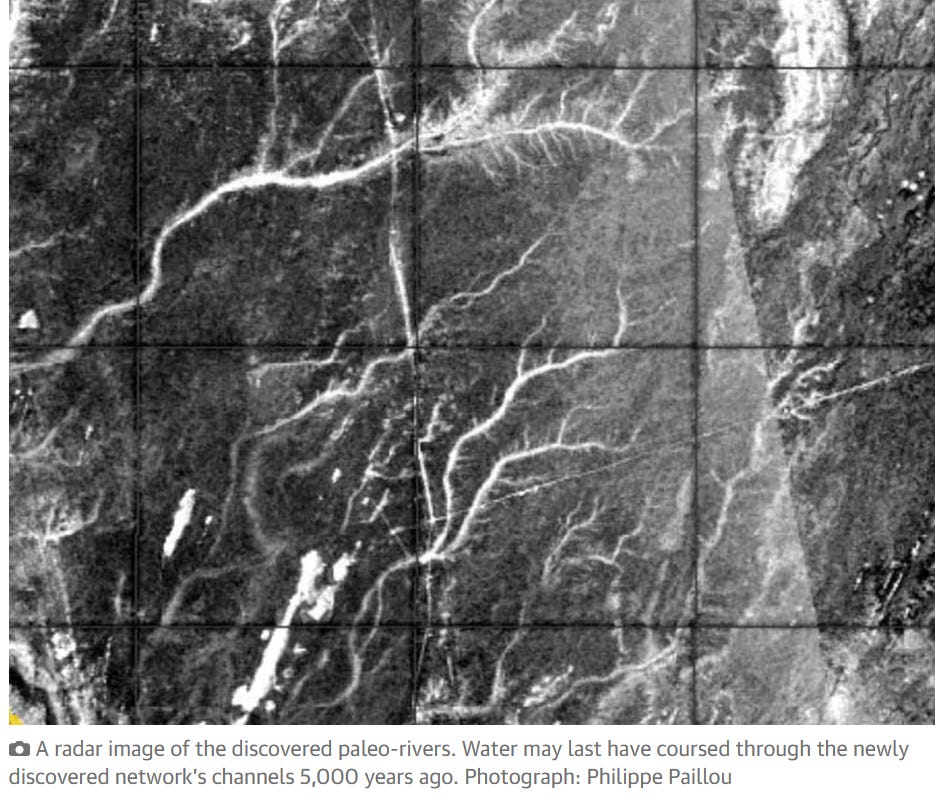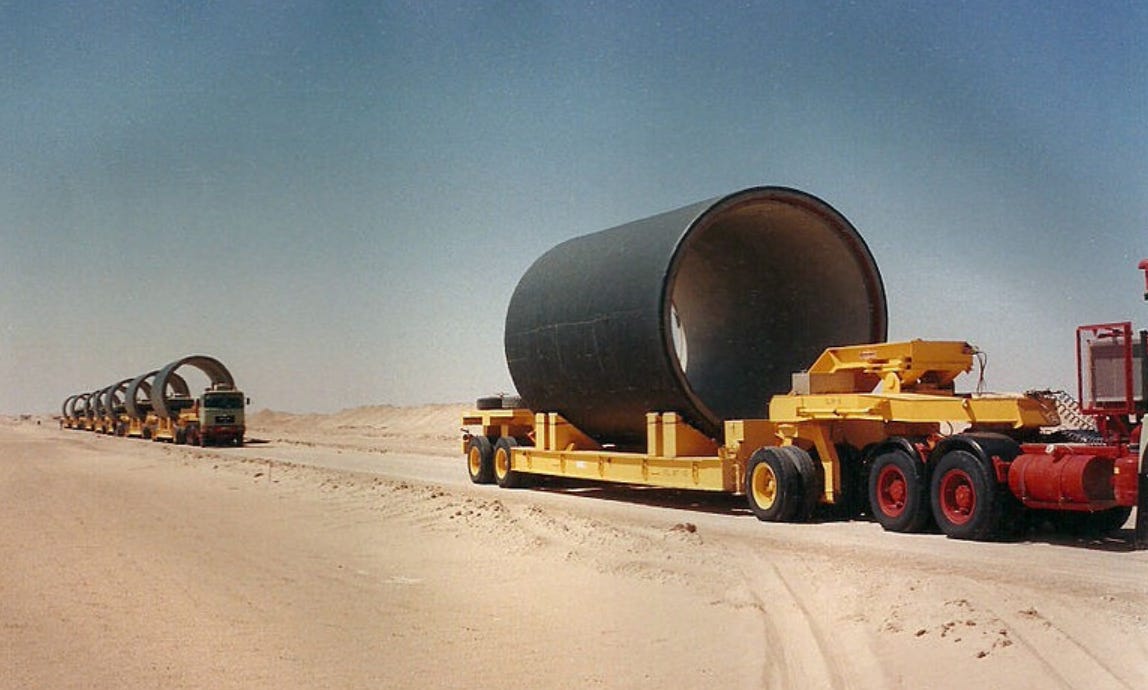the “Great Man-Made River” - water in the desert
A brief update - If you missed it, check out Past Climate Extremes. - It was about “the dust bowl in the 30s with record high temps and record drought, the medieval warm period, the polar warm period, the ice age, 400’ variation in sea levels, river beds under the Sahara Desert, forest fires ofm 1894 and 1910, climate extremes in Europe, vulnerability of the power grid, more sanctions, ESG investing, solar saturation point, bitcoin price surge, and finally, Noah’s Flood - the biggest climate change of all!”
Here’s the part written earlier about past rivers in the Sahara Desert, and then keep reading to see what I learned about the vast lakes of water under the sand and the largest engineering project ever - piping millions of gallons of water from under the desert up to the northern coast of Libya, a project Muammar Gaddafi called the “Great Man-Made River”.
river under Sahara sands
Imagine the difference in “climate” just a few thousand years ago in what is now the Sahara Desert:
the Guardian, 2015:
“A vast river network that once carried water for hundreds of miles across Western Sahara has been discovered under the parched sands of Mauritania. Radar images taken from a Japanese Earth observation satellite spotted the ancient river system beneath the shallow, dusty surface, apparently winding its way from more than 500km inland towards the coast…images taken from the satellite revealed that the hidden river beds aligned almost perfectly with a huge underwater canyon that extends off the coast of Mauritania into waters more than three kilometres deep (almost 10,000 feet)…It tells us that as recently as five to six thousand years ago, the Sahara desert was a very vibrant, active river system.” We’re not talking about millions of years ago – just a few thousand!
2024 update - what I learned since
I wasn’t aware until now that there are huge lakes of water under the Sahara sands, and a fantastic story about the civil engineering project to pipe it to northern Libya. This is another indication that the climate was very different in the past. It may also be considered an evidence of the global flood in the days of Noah, when the whole earth was covered with water.
Huge water resource exists under Africa By Matt McGrath, Science reporter, BBC World Service
“Scientists say the notoriously dry continent of Africa is sitting on a vast reservoir of groundwater.
They argue that the total volume of water in aquifers underground is 100 times the amount found on the surface…
Where there's greatest ground water storage is in northern Africa, in the large sedimentary basins, in Libya, Algeria and Chad," she said.
The amount of storage in those basins is equivalent to 75m thickness of water across that area - it's a huge amount.
Due to changes in climate that have turned the Sahara into a desert over centuries many of the aquifers underneath were last filled with water over 5,000 years ago.
The scientists collated their information from existing hydro-geological maps from national governments as well as 283 aquifer studies.
The researchers say their new maps indicate that many countries currently designated as "water scarce" have substantial groundwater reserves.”
surprise - the underground water aquifer in northern Africa is partially replenished seasonally
According to Science Daily, “The Sahara conceals large quantities of water stored at depth and inherited from ancient times. A recent study by the IRD and its partners has just shown that this groundwater is not entirely fossil, but resupplied every year. Using a method based on data obtained by satellite, scientists estimated the variations in the volume of water lying under the northern Sahara desert: the current rate of recharge is on average 1.4 km3 per year, for the period 2003-2010. This represents 40% of withdrawals, mainly for irrigation to support the oasis economy. The inputs therefore do not compensate for the withdrawals, but their existence means that these transboundary aquifers, the main water resource of semi-arid regions in Algeria and Tunisia, could be managed sustainably.”
Gaddafi’s “8th wonder of the world”
Maybe I’m just showing my ignorance, but I had never heard of this Herculean civil engineering project -perhaps because the story was eclipsed by the war in Syria.
From Amusing Planet “In 1953, while searching for new oilfields in southern Libya, vast quantities of ancient water aquifers were discovered. The exploration team discovered four huge basins with estimated capacities of each ranging between 4,800 and 20,000 cubic km. Most of this water was collected between 38,000 and 14,000 years ago, before the end of the last ice age, when the Saharan region enjoyed a temperate climate.
After Gaddafi and the Free Unitary Officers seized power in a bloodless coup in 1969, the new government immediately nationalized the oil companies and started using the revenues from oil to set up hundreds of bore wells to bring fresh water from the desert aquifers. Initially, Gaddafi planned to set up large-scale agricultural projects in the desert where the water was found, but when the people displayed reluctance to move, he conceived a plan to bring the water to the people instead…
…In August 1984, Muammar Gaddafi laid the foundation stone for the pipe production plant at Brega, and the Great Man-Made River Project began. Around 1,300 wells were dug into the desert soil, some up to 500 meters deep, to pump water from the subterranean water reserve. The pumped water is then distributed to 6.5 million people living in the cities of Tripoli, Benghazi, Sirte and elsewhere through a network of underground pipes 2,800 km long. When the fifth and final phase of the project is complete, the network will have 4,000 km length of pipes that will enable 155,000 hectares of land to be cultivated. Even with the last two phases yet to complete, the Great Man-Made River is the world's largest irrigation project.
Since the fall of Gaddafi in 2011, Libya has been a chaotic mess of warring factions with no central government. Who knows whether the pipeline infrastructure supplying water to the north coast will remain intact and usable? Or whether there is enough electricity generation to run the huge pumps? But the main takeaway for a study of past climate change is that there once was plenty of water where the Sahara Desert is now.







